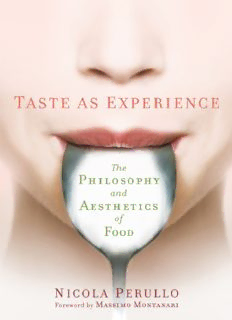
Taste as Experience: The Philosophy and Aesthetics of Food PDF
Preview Taste as Experience: The Philosophy and Aesthetics of Food
TASTE AS EXPERIENCE Arts and Traditions of the Table ARTS AND TRADITIONS OF THE TABLE: PERSPECTIVES ON CULINARY HISTORY ALBERT SONNENFELD, SERIES EDITOR For a complete list of books in the series, see Series List. TASTE AS EXPERIENCE THE PHILOSOPHY AND AESTHETICS OF FOOD Nicola Perullo COLUMBIA UNIVERSITY PRESS NEW YORK COLUMBIA UNIVERSITY PRESS Publishers Since 1893 New York Chichester, West Sussex cup.columbia.edu Copyright © 2016 Columbia University Press Italian edition: Il Gusto come esperienza, copyright © 2012 Slow Food Editore S.r.l. Via della Mendicità Istruita, 45–12042 Bra (Cn) Italy Phone: +39 0172 419611; Fax +39 0172 411218 [email protected]—www.slowfood.it—www.giunti.it All rights reserved E-ISBN 978-0-231-54142-8 Library of Congress Cataloging-in-Publication Data Perullo, Nicola, 1970- [Gusto come esperienza. English] Taste as experience : the philosophy and aesthetics of food / Nicola Perullo. — American edition. pages cm. — (Arts and traditions of the table) Translation of: Il gusto come esperienza. Bra, 2012. Includes bibliographical references and index. ISBN 978-0-231-17348-3 (cloth : alk. paper) 1. Gastronomy. 2. Taste. I. Title. TX641.P47313 2016 641.01'3—dc23 2015024701 A Columbia University Press E-book. CUP would be pleased to hear about your reading experience with this e-book at cup- [email protected]. Cover design: Mary Ann Smith Cover image: © Pando Hall/Getty References to Internet Web sites (URLs) were accurate at the time of writing. Neither the author References to Internet Web sites (URLs) were accurate at the time of writing. Neither the author nor Columbia University Press is responsible for URLs that may have expired or changed since the manuscript was prepared. CONTENTS Preface to the American Edition Foreword by Massimo Montanari INTRODUCTION The Project Difficulties and Resistances Possibilities and Perspectives FIRST MODE OF ACCESS: PLEASURE Pleasure, Enjoyment, and Intelligence Pleasure, Image, and Pathology Criticism and the Look of Childhood Pleasure as Nature in Culture The Ethics of Pleasure: Good That Does “Good” SECOND MODE OF ACCESS: KNOWLEDGE Learning About Quality, Cultivating Taste Tasting the World Dressed Taste, Image, and Representation Taste, Conflicts, and Culture Curiosity, Expertise, Criticism (with Risks Included) Taste and Sustainability: The Good That Grounds the Good Taste and Diet THIRD MODE OF ACCESS: INDIFFERENCE Essen Non Est Percipi Contingent Indifference Compulsive Indifference and Atmospheric Indifference The Neutral The Extension of Pleasure and the Limits of Gustatory Exclusivism THE WISDOM OF TASTE, THE TASTE OF WISDOM Taste and Pleasure, Experience, and Wisdom Wise Expertise (Epicurus, Hume, and Dewey) Regulation Without Rules Flexibility: The Forest and the Coast Conviviality: Discord and Gustatory Empathy Take My Advice Notes References Index PREFACE TO THE AMERICAN EDITION WHEN GOOD IS THE WISDOM OF TASTE: THREE STEPS TO A BETTER PERCEPTION IN EXPERIENCING FOOD To demonstrate how honored and pleased I am to have this book translated into English for the American edition, I would like to briefly depict the motivation that generated it. This essay is the result of the intertwining of my theoretical reflection as a philosopher and my practical experience as a food and wine lover over the past twenty years. My initial interest in wine and food at the beginning of the 1990s was by chance, and only after a certain number of years was my expertise directed toward a theoretical path. Nevertheless, the theorizing that you will find in these pages is heterodox and not systematic. In fact, I have always found the valorization of food that doesn’t take into account its experiential, narrative, and practical dimension to be paradoxical. Today this paradox looms large: there are numerous conventions, in many disciplines or cross-disciplines, on the importance of taste and gastronomy in which care is not taken to organize good convivial settings, to eat good food or drink good wine. Indeed, in some cases, there is only speaking and no eating. Either one speaks or one eats: this aut aut expresses a dichotomous and hierarchizing point of view on which much of our culture is based. Instead, the convivial experience proposes a different perspective in which real eating and metaphorical eating intertwine. In effect, in the humanities and in philosophy there are different ways of approaching food as a theme of study, but I believe that increasing interest in this matter has been driven mainly by two different strategies. The first one can be called the “rising strategy”: food is important because it is Culture with capital C, that which is also called “high” culture in contrast to “simple” and “material” culture. This strategy has already been clearly expanded today. The second strategy, on the other hand, can be named the “lowering strategy”: food is important because all
Description: